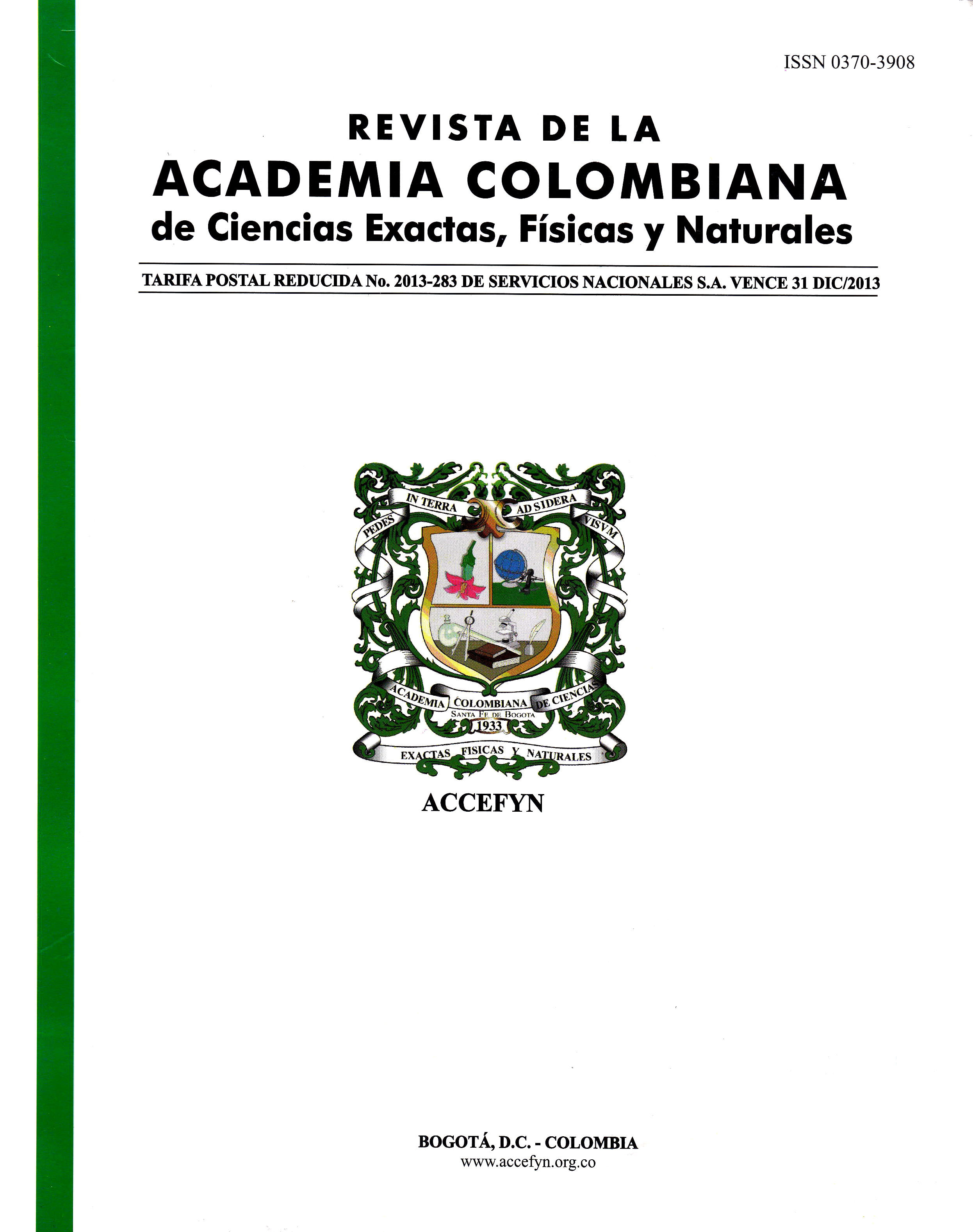Resumen
El presente trabajo, describe el desarrollo de una estrategia metodológica para acelerar y simplificar la detección e identificación de los compuestos producidos en cuatro medios de cultivo diferentes, por 14 bacterias del phylum Firmicutes simbiontes del octocoral Pseudopterogorgia elisabethae de la Isla de Providencia, Caribe Sur-Occidental. El proceso involucró la miniaturización de los cultivos bacterianos, la extracción en fase sólida de los productos usando la resina DiaionTM HP-20, el análisis por UPLC-MS de los mismos y finalmente la generación de una librería que permitió descartar los componentes o productos de descomposición de los medios de cultivo, además de detectar 46 compuestos producidos por el total de las bacterias y la posterior identificación de 10 de ellos, haciendo uso de la base de datos Antibase 2007TM como herramienta de derreplicación de las sustancias detectadas.
Referencias
Ardrey RE. 2003. Liquid chromatographic-mass spectrometry: An introduction. John Wiley & Sons Ltda. Chichester, England. ISBN: 0-471-49801-7.
Berdy J. 2005. Bioactive microbial metabolites. J Antibiot 58:1-26.
Berrue F, Ibrahim A, Boland P, Kerr R. 2009. Newly isolated marine Bacillus pumilus (SP21). A source of novel lipoamides and other antimicrobial agents. Pure Appl. Chem. 81:1027-1031.
Berrue F, Withers ST, Haltli B, Withers J, Kerr R. 2011. Chemical screening method for the rapid identification of microbial sources of marine invertebrate-associated metabolites. Mar Drugs 9:369-381.
Blunt JW, Copp BR, Munro HM, Northcote PT, Prinsep MR. 2009. Marine natural products. Nat Prod Rep 26:170-244.
Blunt JW, Copp BR, Munro HM, Northcote PT, Prinsep MR. 2011. Marine natural products. Nat Prod Rep 28:196-268.
Correa H, Valenzuela AL, Ospina LF, Duque C. 2009. Anti-inflammatory effects of the gorgonian Pseudopterogorgia elisabethae collected at the Islands of Providencia and San Andrés (SW Caribbean). J Inflamm 6:doi: 10.1186/1476-9255-6-5.
Correa H, Aristizabal F, Duque F, Kerr R. 2011a. Cytotoxic and antimicrobial activity of pseudopterosins and secopseudopterosins isolated from the octocoral Pseudopterogorgia elisabethae of San Andrés and Providencia Islands (Southwest Caribbean Sea). Mar Drugs 9:334-344.
Correa H, Haltli B, Duque C, Kerr R. 2011b. Bacterial community associated with the octocoral Pseudopterogorgia elisabethae collected at Providencia Island (SW Caribbean sea). En preparación.
Duque C, Puyana M, Narvaez G, Paz A, Osorno O, Hara N, Fujimoto Y. 2004. Pseudopterosins P-V. New compounds from the gorgonian octocoral Pseudopterogorgia elisabethae from Providencia Island, Colombian Caribbean. Tetrahedron 60:10627-10635.
Duque C, Puyana M, Castellanos L, Arias A, Correa H, Osorno O, Asai T, Hara N, Fujimoto Y. 2006. Further studies on the constituents of gorgonian octocoral Pseudopterogorgia elisabethae collected in San Andrés and Providencia islands, Colombian Caribbean: isolation of a putative biosynthetic intermediate leading to erogorgiane. Tetrahedron 62:4205-4213.
Egan S, Thomas T, Kjelleberg S. 2008. Unlocking the diversity and biotechnological potential of marine surface associated microbial communities. Curr Opin Microbiol 11:219-225.
Flatt P, Gautschi J, Thacker R, Musafija-Girt M, Crews P, Gerwick W. 2005. Identification of the cellular site of polychlorinated peptide biosynthesis in the marine sponge Dysidea (Lamellodysidea) herbacea and symbiotic cyanobacterium Oscillatoria spongeliae by CARD-FISH analysis. Mar Biol 147:761-774.
Heckrodt TJ, Mulzer J. 2005. Marine natural products from Pseudopterogorgia elisabethae: structures, biosynthesis, pharmacology, and total synthesis. In Natural products synthesis II. Volumen 244. 1st edition. Edited by Mulzer J. New York: Springer Berlin Heidelberg 1-41.
Hildebrand M, Waggoner LE, Lim GE, Sharp KH, Ridley CP, Haygood MG. 2004. Approaches to identify, clone, and express symbiont bioactive metabolite genes. Nat Prod Rep 21:122-142.
Hill RT, Enticknap JJ, Peraud O, Anderson MA, Kasanah N, Rao KV, Bowling JJ, Hamann MT. 2007. Microbial symbionts of marine invertebrates: Implications for drug discovery. Conference Programme and Proceedings. Manapro XII, Auckland, New Zealand.
Ito T, Odake T, Katoh H, Yamaguchi Y, Aoki M. 2011 High-Throughput profiling of microbial extracts. J Nat Prod 74:983-988.
Li J, Chase HW. 2010. Development of adsorptive (non-ionic) macroporous resins and their uses in the purification of pharmacologically-active natural products from plant sources. Nat Prod Rep 27:1493-1510.
Marrero J, Rodriguez II, Rodriguez AD. 2010. The natural products chemistry of the gorgonian genus Pseudopterogorgia (Octocorallia:Gorgoniidae). In Comprehensive natural products II: chemistry and biology. 1st edition. Edited by Mander L, Liu H-W. Oxford: Elsevier, p. 363-428.
Mayer AMS, Glaser KB, Cuevas C, Jacobs RS, Kem W, Little RD, McIntosh JM, Newman DJ, Potts B, Shuster DE. 2010. The odyssey of marine pharmaceuticals: a current pipeline perspective. Trends Pharmacol Sci 31:255-265.
Mouchka ME, Hewson I, Harvell CD. 2010. Coral-associated bacterial assemblages: current knowledge and the potential for climate-driven impacts. Integr Comp Biol 50:662-674.
Mydlarz LD, McGinty ES, Harvell CD. 2010. What are the physiological and immunological responses of coral to climate warming and disease?. J Exp Biol 213:934-945.
Newman D, Hill R. 2006. New drugs from marine microbes: the tide is turning. J Ind Microbiol Biotechnol 33:539-544.
Penesyan A, Kjelleberg S, Egan S. 2010. Development of novel drugs from marine surface associated microorganisms. Mar Drugs 8:438-459.
Piel J. 2006. Bacterial symbionts: prospects for the sustainable production of invertebrate-derived pharmaceuticals. Curr Med Chem 13:39-50.
Ridley CP, Bergquist PR, Harper MK, Faulkner DJ, Hooper JNA, Haygood MG. 2005. Speciation and biosynthetic variation in four dictyoceratid sponges and their cyanobacterial symbiont Oscillatoria spongeliae. Chem Biol 12:397-406.
Sudek S, Lopanik NB, Waggoner LE, Hildebrand M, Anderson C, Liu H, Patel A, Sherman DH, Haygood MG. 2007. Identification of the putative bryostatin polyketide synthase gene cluster from “Candidatus Endobugula sertula”, the uncultivated microbial symbiont of the marine bryozoan Bugula neritina. J Nat Prod 70:67-74.
Toyo’oka T. 2008. Determination methods for biologically active compounds by ultra-performance liquid chromatography coupled with mass spectrometry: application to the analyses of pharmaceuticals, foods, plants, environments, metabonomics, and metabolomics. J Chromatogr Sci 46:233-247.
Yao S, Wu T, Li X, Tu B, Song H. 2010. Ten years of research into phytomedicines analysis-an era in new technologies and methods. Curr Pharm Anal 6:269-288.

Esta obra está bajo una licencia internacional Creative Commons Atribución-NoComercial-SinDerivadas 4.0.
Derechos de autor 2023 https://creativecommons.org/licenses/by-nc-nd/4.0

